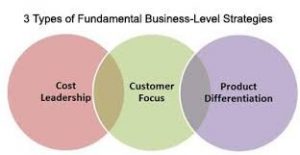Porter’s Generic Strategies
In 1980 Michael Porter described three generic strategies which a company of any size (small, medium or big) can choose to pursue its competitive advantage. The three generic strategies are lower cost, differentiated or focus. A company can choose one of two types of competitive advantage; either lower costs than its competitors or differentiating itself along dimensions valued by customers to command a higher price. A company also chooses one of two types of scope, either focus by offering its products to selected segments of the market or mass market, offering its product across many market segments. The generic strategy reflects the organization’s strategic power.
Competitive advantage is a distinguishing trait of the business which may include access to natural resources, firm’s location, supple supply chain, marketing channels, highly skilled personnel, geographic location, high entry barriers, etc. It can also be technological superiority, brand power which can provide competitive advantage, whether as a part of the product itself, as an advantage to the making of the product, or as a competitive aid in the business process.
Porter suggested that a company must choose one of the three strategies at a time; if it makes a wrong decision it may risk losing its precious resources. He says that to accomplish competitive advantage the firm must have the abilities to cope with the five forces in the market; competition between existing players, bargaining power of buyers, bargaining power of suppliers, threat of new entrants and threat of substitution.
Wal-Mart Stores Inc. has been successful using cost leadership strategy very well for over years. The store has been attracting buyers with low prices; the low prices are offered every day to attract customers. The products are offered at a cheaper rate than competitors consistently, not occasionally. Wal-Mart is able to carry on the gigantic business due to its large scale and efficient supply chain management. They source products from cheap domestic suppliers and from low-wage foreign markets. This allows the company to sell their items at low prices and they earn profits through thin margins gained from high volumes of business.
In cost leadership strategy companies charge a lower price but their volumes are larger. Therefore, volume of business allows a company to maintain its profits and expand its market share. Some consumers shop only at stores that offer the lowest price, which means industries like groceries, fast foods and garments often have price wars. The winner in a price war enjoys protection from rivals because competitors lose out on their profits when they attempt to offer the lowest price. The cost leadership strategy also makes it difficult for new companies to enter the market because of thin profit margins.
 Another brilliant example of cost leadership is the Swedish furniture retailer Ikea. This company offers furniture at amazing low price. It’s the best example of innovativeness. Ikea is able to keep its prices low because it sources its products from low-wage countries. It saves on labour cost and it does not assemble or deliver furniture; customers must collect the furniture from the warehouse and assemble at home themselves. Thought from convenience point of view this is less suitable, customers still buy it from Ikea because of the lowest price tags.
Another brilliant example of cost leadership is the Swedish furniture retailer Ikea. This company offers furniture at amazing low price. It’s the best example of innovativeness. Ikea is able to keep its prices low because it sources its products from low-wage countries. It saves on labour cost and it does not assemble or deliver furniture; customers must collect the furniture from the warehouse and assemble at home themselves. Thought from convenience point of view this is less suitable, customers still buy it from Ikea because of the lowest price tags.
 Product Differentiation strategy:
Product Differentiation strategy:
Porter says that an industry has multiple segments that can be targeted by a firm. The breadth of its targeting refers to the aggressive capacity of the business. If a company targets customers in most or all segments based on characteristic or trait (size, shape, uniqueness, service etc) other than price it is opting for product differentiation strategy.
Etsy is an online artisan store and shopping gallery which has used differentiation strategy wisely. Etsy offers its users a platform to showcase their handmade wares and sell them to customers around the world. Hence this store is called as a crafter’s paradise. Etsy has carved a niche for itself through sales of craft supplies as well as homemade items. Through Etsy, the community of crafters has found a home on the internet and the world has been opened to the amateur artisan/crafter those who wish to sell their products. The Etsy business model brings together the artists and the business savvy of investors who are keen to support the ideas and talent of craftsmen. This business model has worked wonders for Etsy.
Differentiation is a marketing term used to describe the process of developing promotional messages that distinguish products from those offered by competitors. The differentiation plank is created in the minds of target customers. Effective differentiation is critical to building a strong business model. Samsung has adopted differentiation strategy by providing its customers large numbers of service centers network, online technical support, entertaining online complaints, live chats with customers and phone support. Each year Samsung invests minimum 9% of its sales revenue in R&D activity. It believes in innovative concepts and innovative marketing strategies. It has mapped out a plan of reaching $ 400 billion revenue and becoming the leader globally in appliances market by 2020.
Differentiation strategy involves making the products or services diverse yet attractive than competitors. How a company does this depends on the nature of the industry. Differentiation involves product features, functionality, durability, support, service quality, time and also brand image which the customers value. To make a success of a Differentiation strategy, organizations need good research and development, innovation and the ability to deliver high-quality product or service. It also requires effective sales and marketing team, so that the market understands the benefits offered by the differentiated offerings.
Large organizations pursuing differentiation strategy need to stay supple with their new product development processes. Otherwise, they risk attack on several fronts by competitors pursuing differentiation strategies in different market segments.
 The Customer Focus Strategy (Niche marketing):
The Customer Focus Strategy (Niche marketing):
Companies that use Focus strategies concentrate on particular niche markets and, by understanding the dynamics of that market and the unique needs of customers within it, by developing uniquely low-cost or well-specified products for the market. By doing so, the company also enjoys deep economies of scale. The company enjoys effective insights because of the smaller size of market. Thus, automatically the company enjoys market power within the niche. The only challenge in using customer focus strategy or niche market strategy is choosing markets where the customers are lesser prices sensitive.
Because of choosing the right markets and serving customers uniquely well, companies enjoy strong brand loyalty amongst their customers. This makes their particular market segment less attractive to competitors.
In the focus strategy, it is still essential to decide whether a company would like to pursue Cost Leadership or Product Differentiation. Focus is not normally enough on its own. But whether the company uses Cost Focus or Differentiation Focus, the key to making a success of a generic focus strategy is to ensure that it offers its customers that ‘something extra’ as a result of serving only that market niche. The “something extra” that the organizations adds can contribute to reducing costs or to increasing differentiation.
As with its suppliers, the organization does not enjoy the bargaining power because of the lower volumes. But, because of practically no other substitutes to compete with, the company can pass on benefits to its customers.
Examples of niche markets are organic foods which are more expensive, but with promise of better quality and enhanced for environment protection. Another example of a niche is of traditional 35mm film cameras and films; these have become rare. The producers no longer enjoy the same economies of scale, but some consumers still like to use it. The internet has amplified the potential for niche markets and niche businesses. Because of it, the startup cost has been reduced and made it easier to reach a small number of niche customers.
The best example I would quote here is of Café Coffee Day in India. This chain of coffee restaurants brought in the concept of cafes to India where the young and the old can sit for a while, chat, discuss, and meet over a steaming cup of coffee. The first one opened in 1996 on Brigade Road in Bangalore. At CCD, people can have leisure meetings. Nobody disturbs or asks you to vacate the table. The concept instantaneously became a hit. It has a target audience of educated, serious people in big cities and metros where meeting places are in shortage. Another appreciation CCD has capped is that there are also 11,000 small growers in India from whom they source coffee from.
 Porter’s advise on choosing the right strategy: Porter says that organizations must spend time and efforts before they make choice of which generic strategy to pursue because it underpins every other strategic decision. He cautions organizations to use not more than one strategy. One of the most important reasons why companies must use only one of the three strategies is because the entire planned feeling revolves around it. Cost Leadership requires a very detailed internal focus on processes. Differentiation, on the other hand, demands an outward-facing, highly creative approach. So, when companies need to choose one out of three strategies they need to take into account their SWOT analysis. Also organizations need to do the five force analysis of the industry. After doing so the following questions need to be answered:
Porter’s advise on choosing the right strategy: Porter says that organizations must spend time and efforts before they make choice of which generic strategy to pursue because it underpins every other strategic decision. He cautions organizations to use not more than one strategy. One of the most important reasons why companies must use only one of the three strategies is because the entire planned feeling revolves around it. Cost Leadership requires a very detailed internal focus on processes. Differentiation, on the other hand, demands an outward-facing, highly creative approach. So, when companies need to choose one out of three strategies they need to take into account their SWOT analysis. Also organizations need to do the five force analysis of the industry. After doing so the following questions need to be answered:
- Whether supplier’s bargaining power can be reduced or managed.
- Whether customer’s bargaining power can be reduced or managed.
- How to face rivalry among the existing players.
- Whether substitution threat can be reduced or managed.
- Whether threat of new entrants can be managed.
Thus, companies must select the generic strategy that gives them the strongest set of options because it is the starting point of strategic decisions making.














































